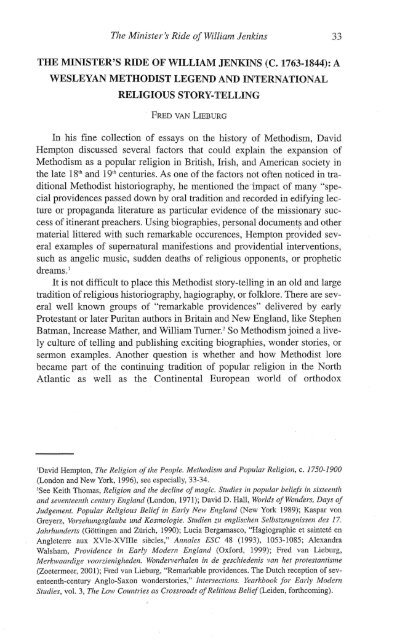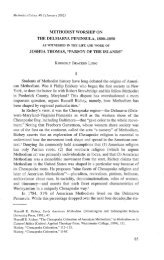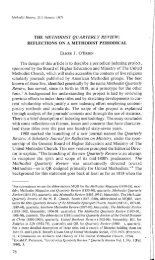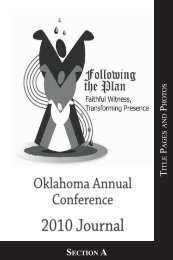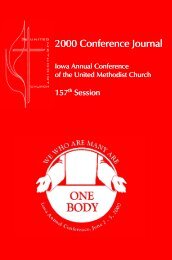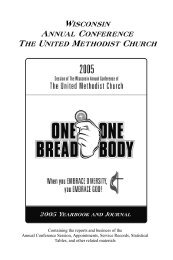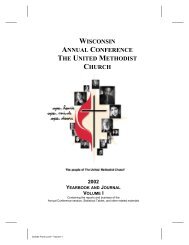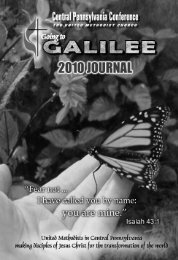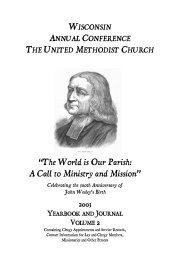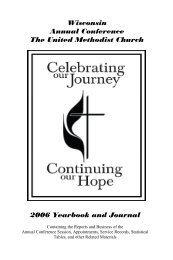You also want an ePaper? Increase the reach of your titles
YUMPU automatically turns print PDFs into web optimized ePapers that Google loves.
34 Methodist History<br />
Protestantism or Evangelicalism. 3 In the following article I want to show that<br />
there are evident links between British Methodism on the one hand, and<br />
Dutch and German Pietism or Revivalism on the other hand, in the field of<br />
oral tradition in the l 9 1 h and 20 1 h centuries, and even of present-day religious<br />
story-telling.<br />
My initial focus is on a story about a Methodist itinerant preacher that<br />
took place in Wales around 1800, but was not published before 1925. Then<br />
it appeared in a collection Legends of the Severn Valley, edited by Alfred<br />
Rowberry Williams. 4 In his preface, Williams referred to the mass of regional<br />
folklore, since both sides of the River Severn were believed to be popµlated<br />
with fairies, goblins, witches, wizards, black dogs, ghosts, saints,. and<br />
human beings with odd and uncanny reputations. From these he has tried to<br />
preserved a few records with antiquarian or literary value, throwing light<br />
upon the mentality of the past and a little upon its history. Williams draw his<br />
legends from many different sources some of which made their first appearance<br />
in his collection. The story I shall deal with, called "The Minister's<br />
Ride," was published from oral tradition. Since its contents are essential for<br />
my comparison with other story-types, and because Williams' collection is<br />
hard to find in libraries, I will first give the text in extenso.<br />
I<br />
At the beginning of last century Methodism was a potent force in the religious life of the<br />
community, but possessed few chapels of its own or regular ministers. These deficiencies were<br />
supplied by amateurs, enthusiastic laymen and laywomen preaching in the open air or in any<br />
room or building where two or three could be gathered together.<br />
Along the Welsh border, on the slopes of a range of hills and mountains overtopped by the<br />
towering peak of Moel Aled, were scattered cottage and farms and tiny villages inhabited by a<br />
hardy, frugal race of shepherds and peasant farmers. Amongst these Methodism took firm hold,<br />
and its itinerant preachers received patient hearing and eventually a warm welcome in farm<br />
kitchens and cottage houseplaces. Even sheds and barns were not despised as preaching places<br />
when the weather proved unfavorable to outdoor meetings, though these early missionaries of<br />
the revival of faith preferred the village green, the shade of the ash tree, or the open hillside to<br />
any building.<br />
Soon the numbers and enthusiasm of the believers made the appointment of a regular minister<br />
imperative, and thus the Reverend William Jenkyns made his appearance along the<br />
Mynydd Aled. He was a disciple of John Wesley in belief; in eagerness for the cause, and in<br />
methods. Of middle height and sturdy build, strong and untiring, eloquent in Welsh and English,<br />
3 See Ton Dekker, "Wahre religiose Geschichten in der niederlandischen mi.indlichen und<br />
schriftlichen Tradition," Rheinishches Jahrbuch far Volkskunde, 26 (1985/1986) 93-107;<br />
Reimund & Karin Kvideland, "Chrisliches Erzahlen in norwegischen<br />
Erweckungsbewegungen," Hartmut Eberhart (ed.), Volksfrommigkeit, Referate der 6sterreichischen<br />
Volkskundetagung 1989 in Graz, Wenen, 1990, 219-231; Fred van Lieburg,<br />
"Pietismus," Enzyklopiidie des Miirchens. HandH.16rterbuch zur historischen und vetgleichenden<br />
Erzahlforschung, Band I 0, Akademie der Wissenschaften zu Gottingen (Walter de Gruyter:<br />
Berlin and New York, 2002), 1047-1056.<br />
4 Alfred Rowberry Williams, Legends of the Severn Valley (London [1925)), 11 -20. I thank the<br />
Shropshire County Council for providing a digital version of the relevant parts of the book.
36<br />
Methodist History<br />
ister urged his horse to a faster trot, and took little more notice of his aloof companion. He felt<br />
the bag of money safely attached to his person, his heart beat a trifle faster and he was much<br />
puzzled, but trotted swiftly on. He was used to eccentric people. The worst sensation was the<br />
absence of any sound from behind him. He strained his ears to listen, but the horse and rider<br />
came along noiselessly. There was not even the soft pad-pad of an u.nshod horse. No wonder<br />
the minister felt an increasing sense of mystery and glanced round repeatedly. Every time he<br />
did so the stranger was trotting along in the same way, as if William Jenkyns did not exist.<br />
So they went past the cottages and the peat bog, left the piles of peat far behind, and reaching<br />
the edge of the moor, could see the lights far below them. As they turned off the moorland,<br />
passed the pine trees and staited downhill, Jenkyns looked back again, and still the horseman<br />
rode a few paces away. Now the road was good and familiar, horse and rider felt the call of<br />
home and pressed on faster. William Jenkyns did not look back again till he drew rein at the<br />
hostelry, the "Aled Arms." Then he nearly fell off his horse in surprise, for his travelling companion<br />
was not there. How could he have turned off, because from the pine trees to the "Aled<br />
Amis'' there were walls or hedges each side all the way? Thinking deeply Jenkyns pushed on<br />
and reached Craigderyn without further happenings, and bestowed the money in safety. He was<br />
much puzzled but in no way alarmed, and put it down to be merely some uncivil traveller.<br />
Next day he rode up and made inquiries all the way, at the "Aled Arms," at the shepherds'<br />
huts and farms, and of people living about the district whom he knew. But no one had seen a<br />
tall stranger, wrapped in a cloak, riding on a big white horse. So he gave up the quest, and<br />
though very mystified did not trouble much further about it,. as nothing of the sort ever happened<br />
again, and he was far too busy to worry over a single incident.<br />
III<br />
Coming out of a big farm kitchen where he had conducted a service one Sunday morniµg,<br />
the Reverend William Jenkyns was accosted by a bareheaded and barefooted boy ragged, who<br />
exclaimed breathlessly, "Come to the Llyn Cottages. Dad's hurt, Mam says he's dying." Despite<br />
their unsavory reputation the minister had his horse fetched out, and in a few minutes was trotting<br />
hard across the upland flats to the Llyn Cottages. They were a row of hovels bordering the<br />
peat bog, miserable residences of a miserable race of beings. The inhabitants of these huts were<br />
the Ishmaelites of the mountains. They only of all people perpetually resisted all advances made<br />
by J enkyns, spumed his ministrations, scoffed at his message, insulted him, and did all but offer<br />
personal violence and that they had threatened.<br />
Jenkyns rode past the great piles of peat, turned off the high road across the spongy turf<br />
and drew rein before the cottages. A dishevelled woman ran out of one, crying, "Oh, sir, come<br />
to my husband, He is terribly hurt but says he must speak to you before he dies.''<br />
Stooping his head under the low door-lintel the minister followed her into the hovel. The<br />
place was in -semi-darkness, the reek of peat smoke hung heavily, and a motley group of men<br />
and women and children were gathered at the far side of the room. They fell back dumbly at<br />
the entrance of William Jenkyns,. revealing a man covered by a ragged blanket lying on a heap<br />
of dried bracken spread on the earthen floor. Though he groaned at the effort the man turned his<br />
head and moved convulsively as his wife and the minister came to his side. His face was hag ...<br />
gard and drawn, and his eyes bloodshot with pain Jenkyns dropped on his knees, pushed back<br />
the sufferers matted hair off his brows, and said feelingly, "My brother, God has brought us<br />
together at last."<br />
The man went momentarily calmer, then speaking with great effort, said, "I'm done for. I<br />
shan't last much longer. But I must tell you before I go." William Jenkyns gave the unfortunate<br />
fellow a drink of water, and made him more comfortable. He longed to put him at ease spiritually,<br />
but the man persisted in doing the talking, and seemed to acquire temporary strength for<br />
the purpose. This was what he said: "We were stacking peat this morning. The lot slipped on<br />
me. When they dug me out I was like this. A year ago-I must tell you-I was hiding behind that<br />
pile. To kill you. We had followed your movements. Knew when you would come this way. Boy<br />
watched you start out, and we were let know. And we knew you had a bag of money. We were
The Ministers Ride of William Jenkins 37<br />
going to kill and rob you. Three of us. And a savage dog. Armed with sticks we hid behind the<br />
peat stack and waited. Presently we heard your horse's hoofs on the road. We got ready to slip<br />
the rope off the dog and rush out. When you sounded near we crept out from behind the peat.<br />
And then ... " The narrator struggled for breath; his eyes grew wild and frightened as he resumed,<br />
"I tell you, on our side of the road was a man on a great white horse that made no sound as it<br />
trotted. The man's head was higher than the peat stack. We loosed the dog, but he crouched<br />
down in a hole, trembling and panting. Level with us the big man turned and looked at us. His<br />
eyes shone like stars. Looked right through us. We could not move for fear for a long time after.<br />
We have never robbed anybody since."<br />
The injured man ceased from sheer exhaustion. The minister was overcome with astonishment<br />
and awe. But there was no time for words, except "Thank God!'' and a hasty, silent<br />
prayer. The man's fast glazing eyes were fixed on his in mute agonized appeal. William Jenkyns<br />
clasped the man's hand in his,. laid the other tenderly on the perspiJ;ing forehead, and said clearly,<br />
"Father, forgive him, as Thy Son did .... " A look of relief and ease had barely time to overspread<br />
the man's features before he breathed his last and died.<br />
IV.<br />
Never before had the Reverend Williams Jenkyns moved a congregation as he did at a great<br />
Preaching Meeting shortly afterwards when he recounted in eloquent detail his ride with the<br />
money accompanied by the silent stranger, and the subsequent confession and death of the peat<br />
cutter. It created an immense revival of faith.<br />
Reading this story from the collection of Severn legends, one might not<br />
put any trust in it at all. Should we refer "The Minister's Ride" to the domain<br />
of fairy tales or should we verify how much is based on reliable historical<br />
facts? Troubles start with checking the place names mentioned in the story.<br />
Moel Aled and Mynydd Aled sound right. There is a River Aled west of<br />
Denbigh and there might be a Moel (Welsh for hill) and a Mynydd (Welsh<br />
for mountain) near it, but not on any map of the region. Neither can the town<br />
of Craigderyn be recognized as a location in Wales, although there is a hell<br />
called Craig y Deryn in Tywyn in the county of Merioneth. 5<br />
More evidence, however, can be found for the main figure of the story,<br />
William Jenkyns. Let us first note that the 'y' can be take as a phonetical<br />
indifference of 'i.' J enkynses are very rare, while Jenkins is a c01n1non surname.<br />
A certain William Jenkins is mentioned as pastor of the Rehoboth<br />
Congregational church in Bryn-1nawr, Monmouthshire. He played a role in<br />
the beginnings of the Welsh Revival in 1858 and was apparently a Welsh<br />
Calvinistic Methodist. 6 Yet he could be hardly meant by the person of our<br />
story. The horse.,.riding minister was called a pupil of John Weslyy and suggested<br />
to represent the Wesleyan wing of the Methodist inovemenf: Thanks<br />
to the database of Wesley's preachers, con1piled by John Lenton on the basis<br />
of primary sources, and containing all ministers who entered before John<br />
Wesley's death in 1791, we can safely assume that the story is about Williain<br />
5 Cf. Elwyn Davies (ed.), A Gazeteer of Welsh Place-Names (Cardiff, 1975):<br />
6 Michael R. Watts, The Dissenters II. The Expansion of Evangelical Nonconformity 1791-1859<br />
(Oxford, 1995), 662; refeITing to E. Evans, When He is Come (Bala, 1959), 31, 33 .
38 Methodist History<br />
Jenkins, who is known as one of the founders of the Welsh Wesleyan<br />
Methodism at the beginning of the 19th century. 7 What can we say about his<br />
life and work?<br />
According to his age at death, William Jenkins was born around 17 63.<br />
His geographical origin is not known, although the Severn legend makes it<br />
likely that he came from Wales, since he is said to have spoken Welsh.<br />
Regarding his social background, he was destined to become an architect,<br />
just like his cousin John Jenkins. William worked as such before he was<br />
admitted to the Wesleyan ministry in 1788. 8 His name occurs for the first<br />
time in John Wesley's letters in July 1789, in a reference which implies that<br />
he had been preaching in Bedford the previous year, probably for Robert<br />
Empringham. 9 It is curious that his wife Mary was said to be converted by<br />
him in Northampton about this time, being "brought out of the gay and fashionable<br />
world.'' 10 Mary, whose name first appeared as Jenkins' wife in the<br />
Wesleyan Minutes in 1798, bore him at least six children. u<br />
Apparently from his career, Jenkins was a successful and leading minister.<br />
He spent his first period as an Assistant (1788-1797), then he travelled<br />
in important circuits as a Junior Preacher (1797-1803), and then was a<br />
Superintendent ( 1802-1806), everywhere in English regions. Finally he<br />
moved to London, a call that only fell to influential preachers. 12<br />
Unfortunately, his service in the capital city was not long. He superannuated<br />
in 1810 because of failing health and took up his former profession of<br />
architecture, although he was mentioned in the annuaLMinutes until the year<br />
of his death. Meanwhile he was in business in Red Lion Square with his<br />
cousin and later with his sons. He designed or repaired many buildings,<br />
including the Methodist City Road Chapel. 1 J His wife Mary died in London<br />
7 Another Wesleyan Methodist preacher called William Jenkins entered the ministry 1797,<br />
became a missioary at St. Kitts in the West Indies for two years, and died 1830. He was not the<br />
minster in the story because he travelled mostly in Cornwall and never anywhere near the Welsh<br />
border.<br />
8 John Telford, Two West End Chapels (1886), 110-114, for the building of Hinde Street Chapel<br />
in London.<br />
9 John Telford (ed.), The Letters of the Rev. John Wesley (London, 1931), vol. 8, 156.<br />
10 George Stevenson, City Road Chapel, London and its Histori(:al Associations (London, 1872),<br />
548-549.<br />
11 John Lenton's database lists the names of Mary, John, Susan, Joseph, Hesther, and William<br />
Wesley. He also mentions two sons-in-law, H. W. Williams artd Dr. Brewer. If they were not<br />
husbands of one of the daughters just mentioned, William and Mary Jenkins may have had<br />
seven or eight children.<br />
12 According to the Minutes, these were his stations: 1788-90 Bedford, 1791 Lynn, 1792-93<br />
Colchester, 1794-96 Gloucestershire, 1797-98 Bristol, 1799 Stockport, 1800-01 Liverpool,<br />
1802-1803 Manchester, 1804-05 Sheffield, 1806-1810 London.<br />
13 Howard M. Colvin, Biographical Dictionary of British Architects, 1660-1840, 3n1 ed. (New<br />
Haven, 1995). Jenkins designed Hinde Street, the Mint, Exeter, Lambeth, Southwark, Great<br />
Queen Street, Kings Cross, Waltham Street, Hull, Bethel, Rochester, Carver Street, Sheffield,<br />
Walcot, Bath, Canterbury (St. Peter's Church, opened 1812); cf. Proceedings of the Wesley<br />
Historical Society, vol. 36, 64; John A. Vickers, ed, A dictionary of Methodism in Britain and<br />
Ireland (London, 2000), 181.
40 Methodist History<br />
it's not the head waters of that part of Wales where Welsh Methodism started.<br />
On the other hand, William J enkyns was a real preacher, who probably<br />
spoke Welsh, was the close friend of Owen Davies who was the real pioneer,<br />
had influence and spoke in the Conference that paved the way for the organization<br />
and financing of a Welsh speaking circuit. These observations do<br />
not say anything whether the story of the mysterious rider and conversion of<br />
criminals is credible or not. To interpret the oral tradition that seems to be<br />
rooted in historical facts or events, we compare stories about supernatural<br />
protection of religious personalities collected by folklorists and others.<br />
William Jenkins would have had his miraculous experience about 1800,<br />
but the story seems not to have been written before 1925. However, reports<br />
· of similar events appear to have circulated in the course of the l 9 1 h century.<br />
Two examples are recorded in the diaries of the English author Augustus<br />
Hare. First, in 1880 he had a dinner with a friend, Mr. Synge, who declared<br />
his belief in ghostly apparitions. He told an exciting story of a clergyman in<br />
Somersetshire who had ridden to the bank and drawn out all the money for<br />
his poor club. He was taking it back with him, when he became aware of<br />
another horseman riding by his side, who did not speak, and who, at a certain<br />
point of the road beyond a hollow, disappeared. In that ho1low, highwaymen<br />
who knew the clergyman was coming with the money, were waiting<br />
to attack him. But they refrained, "'for there are two of them', they said."<br />
"It was his guardian angel," his partner added. 19<br />
In 1885 Hare heard a second story over dinner, told by Mr. Wharton,<br />
who had heard it from a certain Mr. Bond in a little inn at Ayscliffe. The<br />
story dealt with Johnnie Greenwood from Swancliffe, a chaplain at the<br />
beginning of the century. One night he had to ride through woods a mile long<br />
to make a visit. At the entrance of the woods a large black dog joined him<br />
and pattered along by his side. When he emerged from the wood, the dog<br />
had disappeared, and he could not tell where it had gone. Returning home<br />
after his visit, the dog accompanied him in the wood again. Years later, two<br />
condemned prisoners in York jail told the chaplain that they had intended to<br />
rob and murder Greenwood that nights in the woods, but that he had a large<br />
dog with him, and when they saw that, they felt that Johnnie and the dog<br />
together would have been too much for them. 20<br />
Hare's diaries, including both stoiies about guardians of preachers, were<br />
published in London in 1900. They were later inserted in a dictionary of<br />
British folk-tales compiled by Katharine Briggs. According to Briggs, similar<br />
stories were widespread in the beginning of the century. In a personal<br />
footnote she added to Hare's paragraph on the black dog that she herself was<br />
told a variant of this story as a child in 1910 by an old clergyman, called<br />
Hosey, in London. Another story, Briggs stated, was known in Yorkshire<br />
' 9 Augustus Hare, The Stmy of My Life, vol. 2 (London, 1900), 285-286; also in Hare, In My<br />
Solitary Life (London, 1953 ), 163-164.<br />
211 Hare, The St01y of My Life, 425, also in Hare, Jn My Solitmy LUe, J 88.
The Ministers Ride of William Jenkins 41<br />
"about a well-known non-conformist minister who had been making a charitable<br />
collection in a lonely part of the country." 21 In this context, the extensive<br />
Welsh legend on William Jenkins is discovered to be one of many oral<br />
traditions about heavenly bodyguards seen as angels, dogs, horseriders, and<br />
c1iminals confessing their murder plans against unassailable ministers.<br />
There is more.<br />
In 1934 Charles Lindley Wood, the Viscount of Halifax, died at the age<br />
of 94. He was a lover and collector of supernatural experiences and heard a<br />
lot of stories during his long life, which he wrote down in his "Ghost Book."<br />
His materials were published in two volumes after his death including two<br />
quite similar stories about "hostly guardians." 22 These apparitions would<br />
have occurred about 1890 and were supposed to refer to the same incident.<br />
One tale deals with Edward King, Bishop of Lincoln from 1885 until his<br />
death in 1910, and would have been told by himself at tea. Befor1Y citing the<br />
story, it should be remarked that he was a charismatic personality and an<br />
evangelical Christian. Known as an advocate of the Anglo-Catholic Oxford<br />
Movement, he had at the same time great respect for Methodism. He was an<br />
admirer of John Wesley and like to work in the diocese where Wesley was<br />
born. The following report of his wonderful escape would have happened<br />
while Edward King was serving in Wheatley between 1854 and 1862. 23<br />
When the Bishop was a young man, he was curate in a village. One wet cold night he<br />
had come home very tired and had just got his boots off, when his landlady came in and<br />
said that a farmer, living three miles off across the fields had met with a serious accident<br />
and wanted King to come at once. She did not know the messenger, and he refused to come<br />
in because he was so wet. King put his boots on again and started off; but it was very dark<br />
and he missed the man who had brought the message. When he reached the house to which<br />
he had been summoned, the door was opened to his knock by the fanner himself, hale,<br />
hearty, and much surprised to see his visitor. No message had been sent, and, greatly mystified,<br />
King went home. The man who had summoned him had gone, and the matter<br />
remained unexplained.<br />
Some years afterwards in another county, King was ministering to a dying man in<br />
hospital, and the man said: "Don't you remember me, Sir?" The Bishop could not recall<br />
him until he gave his name, which was that of a very bad character who had lived years<br />
ago in that village where King was a curate .. The man went on: iit was lucky for you that<br />
you brought a friend with you that night when you thought you had a call to the farm. I<br />
meant to murder you, only I couldn't, as there were two of you.' The Bishop had seen and<br />
heard nothing, but the man was certain that he had been accompanied by a second greatcoated<br />
figure walking beside him.<br />
21 Katharine M. Briggs, ed .. , A dictionary of British folk-tales, Part B: Folk legends, Vol. 1<br />
(London, 1971), 14-15, 531.<br />
22 J. G. Lockhart, ed., Lord Halifax's Ghost Book. A Collection of Stories of Haunted Houses,<br />
Apparitions and Supernatural Occurrences made by Charles Lindley, Viscount Halifax, vol. II<br />
(London, 1937), 123-128; reprint, Simon Marsden, ed., The Ghost Book of Charles Lindley,<br />
Viscount Halifax (London, 1994), 83-88.<br />
23 See John Anthony Newton, Searc}1for a Saint: Edward King (London, 1977).
42 Methodist History<br />
This story was told to Lord Halifax by a woman who had heard it from<br />
the Bishop himself several decades before. Meanwhile, the story was also<br />
told to Lord Elton, who published a biography of Edward King in 1958 who<br />
did not know the publication of Halifax. Interestingly, when he sought the<br />
origins of the oral tradition he was told this story was about other people.<br />
One of his informants said the miracle happened to Samuel Wilberforce,<br />
Bishop of Oxford from 1845 to 1873, but King's biographer judiciously supposed<br />
that he in fact meant Samuel's father, William Wilberforce, "who was<br />
even better qualified, one would think, to receive supernatural protection." 24<br />
William was the great abolitionist and pious Methodist to whom John<br />
Wesley wrote his famous deathbed letter against slavery in 1791. I cannot<br />
confirm that old Wilberforce is said to have been protected by ghostly<br />
guardians, but rumor shows that the legend can be associated with holy persons<br />
in religion and with "political saints" as well. 25<br />
Stories about heavenly helpers of pious preachers, like that of Bishop<br />
King, were widespread in the Netherlands during the 20lh century. A number<br />
of them are only known in the short version of the failed murder attack, not<br />
with a full plot including the confession or conversion of the offender(s);<br />
Regarding the mysterious guardians, they were mostly described as angels.<br />
However, the oldest variant of this story-type that I know was published just<br />
at the end of the 19 1 h century in West Germany in a collection ofBergian legends<br />
published by the folklorist Otto Schell in 1897. They dealt with anonymous<br />
pastors in Wichlinghausen and Wiilfrath and were written down in<br />
Bann.en and Elberfeld not long before that year. 26 It is remarkable that the<br />
oral tradition documented by Schell, which remained unknown to the Dutch<br />
folklorists until recently, represents a complete that makes it more likely that<br />
the story is much older.<br />
In the Netherlands the first printed stories about guardian angels of<br />
Protestant ministers appeared in church periodicals in 1920 and 1921, dealing<br />
with a little known Reformed pastor and a famous evangelical preacher.27<br />
The first publication of a similar story by a folklorist was in 1933, which<br />
I will discuss shortly. Since then, many reports concerning religious persons<br />
of different denominations have occurred in oral tradition as well as in sermons,<br />
regional newspapers, or family magazines. Collectors of folktales in<br />
the province of Friesland have noted 32 variants. These were mentioned by<br />
24 Lord Elton, Edward King and Our Times (London, 1958}, 138-140.<br />
25 Standish Meacham, Lord Bishop. The life of Samuel Wilbe1force, 1805-1873 (Cambridge,<br />
MA, 1970).<br />
26 0tto Schell, Bergische Sagen (Elberfeld, 1897), reprint, (Remscheid, 1978), 183-184 (No.<br />
109, Die geheimnisvollen Begleiter) and 205-206 (No. 155, Engel als Beschiitzer).<br />
27 Ds. \V[illem] Raman, Jaarboekje van de Gerefonneerde Kerken in Nederland 1920, 330-331;<br />
"Het leven van wijlen ds. Jan van Petegem,'' OnsOrgaan van de Vrije Evangelisclze Gemeenten<br />
in Nederland, November 1921.
44 Methodist History<br />
a heavy storm and he met nobody. Just near the bridge he passed two men, who seemed<br />
unworried by the weather, apparently sailors going to their ship. Finally he arrived at the<br />
stated address, but to his surprise there burnt no light. He had to knock persistently before<br />
someone opened the door. Then he heard that there must be a mistake. No one had called<br />
for him at all.<br />
Two years later he was woken up again in the middle of the night. He was urged to<br />
go with the messenger, for someone who had been his bitter enemy for years was on the<br />
verge of death. Smytegelt hurried and soon faced the sick man, who told him with sobs<br />
that he had lured him out of the house on the earlier storrny night with the intention of<br />
throwing him over the bridge railing with the help of a friend. However, when Smytegelt<br />
approached the bridge, the minister of God was clearly surrounded by angels before,<br />
behind and beside him, guarding him with flaming swords. His friend had seen nothing,<br />
but was so impressed by the fright of his mate, that he came to conversion too.<br />
This story was published for the first time in the Zeeuwsch Sagenboek<br />
by Mr. and Mrs. Sinninghe in 1933 on the basis of a manuscript collection<br />
of Zeelandish legends from one or two decades before. Curiously, this publication<br />
was read by a lover of folktales, who also knew the collection of<br />
Severn legends of 1925 and immediately remembered the story of the<br />
Methodist preacher. He delivered a Dutch translation of the story about<br />
William Jenkins that appeared in 1934 in a folklore journal as an English<br />
variant of the story on the guardian angels of Bernardus Smytegelt. 32 The<br />
clear similarity of both story types is striking. The mysterious rider on the<br />
horse seems to be replaced by one or more angel figures. A difference<br />
remains that in the English variant, not in the Dutch version, the supernatural<br />
helpers let themselves be seen to the guarded person. Most important<br />
point of comparability, however, is that both stories seem to be backdated in<br />
projecting on charismatic figures in the past.<br />
This way of dealing with religious history or sanctifying pillars of tradition<br />
by telling wonderstories can be seen as a frequent phenomenon in popular<br />
religious culture of any confession or denomination. 33 To give one more<br />
example from Dutch Reformed history, I refer to the Rev. J odocus van<br />
Lodenstein, who is known as a figure-head of Pietism in the 17th century. 34<br />
His first congregation was Zoetermeer in South Holland, where he served<br />
from 1644 to 1650. When a church historian wrote his biography in the<br />
1940s, he heard several stories told by the inhabitants, one of them about<br />
"two men, who wanted to attack Van Lodenstein out of the village, but abandoned<br />
while seeing, wonderfully, not one but three men who set themselves<br />
against them. '' 35 Is this the oldest case of the angel story or is it the recent<br />
32 1. Rasch, "Een Engelsche variant van de engelenwacht van Smytegelt," Eigen Volk 6 (1934),<br />
172-176.<br />
33 fred van Lieburg, "Sanctifying pillars of Pietism. Guardian Angels in European Storytelling/'<br />
Jtirgen Beyer et al., eds., Confessional Sanctity (c. 1550 - c. 1800) (Mainz, forthcoming).<br />
34 Martin Brecht, ed., Geschichte des Pietismus, vol. I (Gottingen, 1993), 783-788. See also Carl<br />
J. Schroeder, Jn Quest of Pentecost: Jodocus van Lodenstein and the Dutch Second Refonnation<br />
(Lanham, 2001).<br />
35 M. J. A. de Vrijer, Ds Bernardus Smytegelt en zijn "Gekrookte Riet'' (Amsterdam, 1947). 69.
46 Methodist History<br />
dark street or park. The next day they read in a newspaper that another<br />
young woman was violated and they went to the police to identify the man<br />
at a lineup. When the offender was arrested and asked why he did not attack<br />
the other girl, he answered she had tall men walking on either side of her. An<br />
early version of this story appeared in an edifying book on angel apparitions,<br />
published in Grand Rapids, Michigan, in 1982. 40 The same stories were told<br />
in the 1990s among evangelical teenagers and collected by folklorists in<br />
Germany and Sweden. 41 They were also widespread in the Netherlands and<br />
in Scotland through a Dutch informant of a Strict Baptist youth magazine. 42<br />
In 2000 the story was put on the internet and placed as the "legen of the<br />
week" at an American website. 43 Here is a paraphrase of a later version mentioned<br />
by a collector who said he has heard the story dozens of times in different<br />
contexts:<br />
Sally, a student of a midwestem college, fell asleep in the library, when cramming for an<br />
exam she had failed the first time. She awoke after midnight, was let out by a janitor, and<br />
although she could have used the service of the campus police, she decided to walk alone<br />
in the dark. She was anxious and prayed silently the whole way, "Oh, Lord, protect me.<br />
Place your angels around me." Sometimes the echo of her own footsteps sounded like<br />
another pair of footsteps. But she made it safely to the door of her dorm when she heard a.<br />
blood curdling scream from bebind her. She ran inside and called the police, but they came<br />
too late. The next day she heard that at that place a girl was not only raped, but murdered<br />
too. The offender was arrested, and of course Sally was an important witness for the police.<br />
Although she was very shocked, she asked if she could speak with the murderer. "Why<br />
didn't youkiJl me?", was her curious question. He replied, ''How stupid do you think I am?<br />
Do you think I would attack a girl with two huge guys on her arm?"<br />
In the meantime, the classic variant of the oral tradition, dealt with in<br />
this article, remains to the present day. In 1997 the story about Bishop<br />
Edward King was written on a leaflet hung in a chapel in the Lincoln<br />
Cathedral as "a prayer in these days of violence and growing anxiety in our<br />
communities." 44 Dutch variants were republished by the Evangelical<br />
Broadcast in a magazine accompanying the American television series<br />
"Touched by an Angel" distribtited in the Netherlands in the Autumn of<br />
2000. 45 However, not only the well-known story of the Rev. Smytegelt was<br />
remembered, a more "modem saint" also became popular in religious storytelling.<br />
This was Comelis Breet, baker and evangelist in the poors quarter of<br />
40 Hope MacDonald, When Angels Appear (Grand Rapids, 1982), 75.<br />
41 Rolf Wilhelm Brednich, Das Huhn mit dem Gipsbein. Neueste sagenhafte Geschichten von<br />
heute (Miinchen, 1993), 138 (no. 101); Bengt af Klintberg, Den stulna njuren. Siigner och l)'kten<br />
i var tid (Stockholm, 1994), 282-284 (no. 100).<br />
42 G. D. Buss, ''He Shall Give His Angels Charge Over Thee," Friendly Companion Magazine,<br />
vol, 124. January 1998, 17.<br />
43 Urban legends and folklore: http://www.urbanlegends.about.com.<br />
44 Information from Alex Adkins, who was not aware of written versions of this legend as I men<br />
tioned from Lord Halifax and Lord Elton.<br />
45 Engelen. Minimagazine, edited by the Evangelische Omroep (Evangelical Broadcast),<br />
Hilversum, 2000, 12-13.
Methodist Histo1y, 41:2 (lanumy 2003)<br />
Whatever assistance God gives to men by men, the same, and frequently in a higher<br />
degree, he gives to them by angels. Does he administer to us by men, light when we are<br />
in darkness; joy, when we are in heaviness; deliverance, when we are. in danger; ease and<br />
health, when we are sick or in pain? It cannot be doubted but he frequently conveys the<br />
same blessings by the ministry of angels: Not so sensibly indeed, but full as effectually;<br />
though the messengers are not seen. Does he frequently deliver us, by means of men, from<br />
the violence and subtlety of our enemies? Many times he works the same deliverance by<br />
those invisible agents. These shut the mouths of the human lions, so that they have no<br />
power to hurt us. And frequently they join with our human friends, (although neither they<br />
nor we are sensible of it,) giving them wisdom, courage, or strength, which all their labour<br />
for us would be unsuccessful. Thus do they secretly minister, in numberless instances, to<br />
the heirs of salvation; while we hear only the voices of men, and see none but men round<br />
about us. 48<br />
4 RJohn Wesley, "Of Good Angels," Albert C. Outler, ed., The Works of John Wesley. Sermons I [I<br />
(Nashville: Abingdon Press, I 987), vol. 3, J 4.


